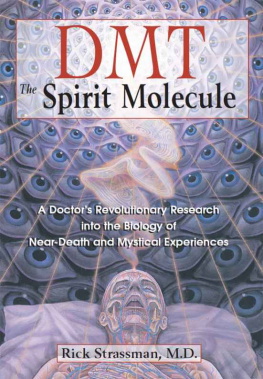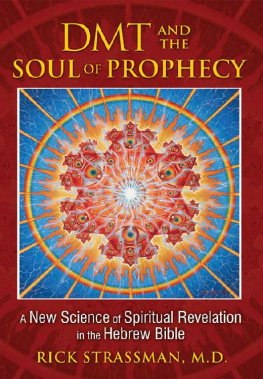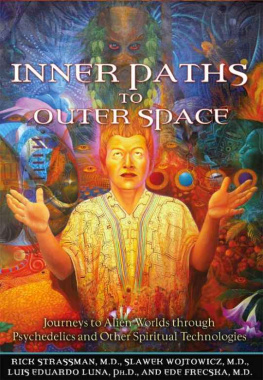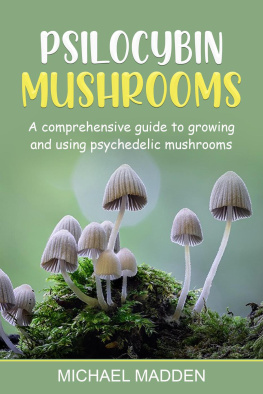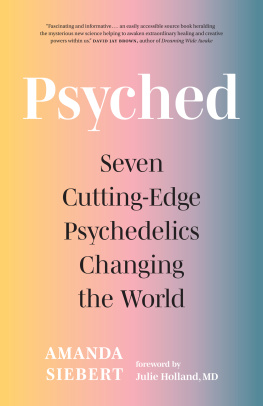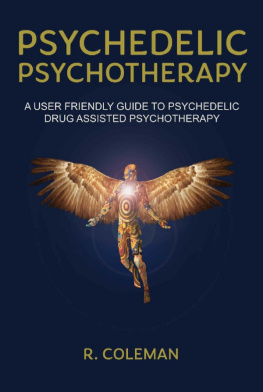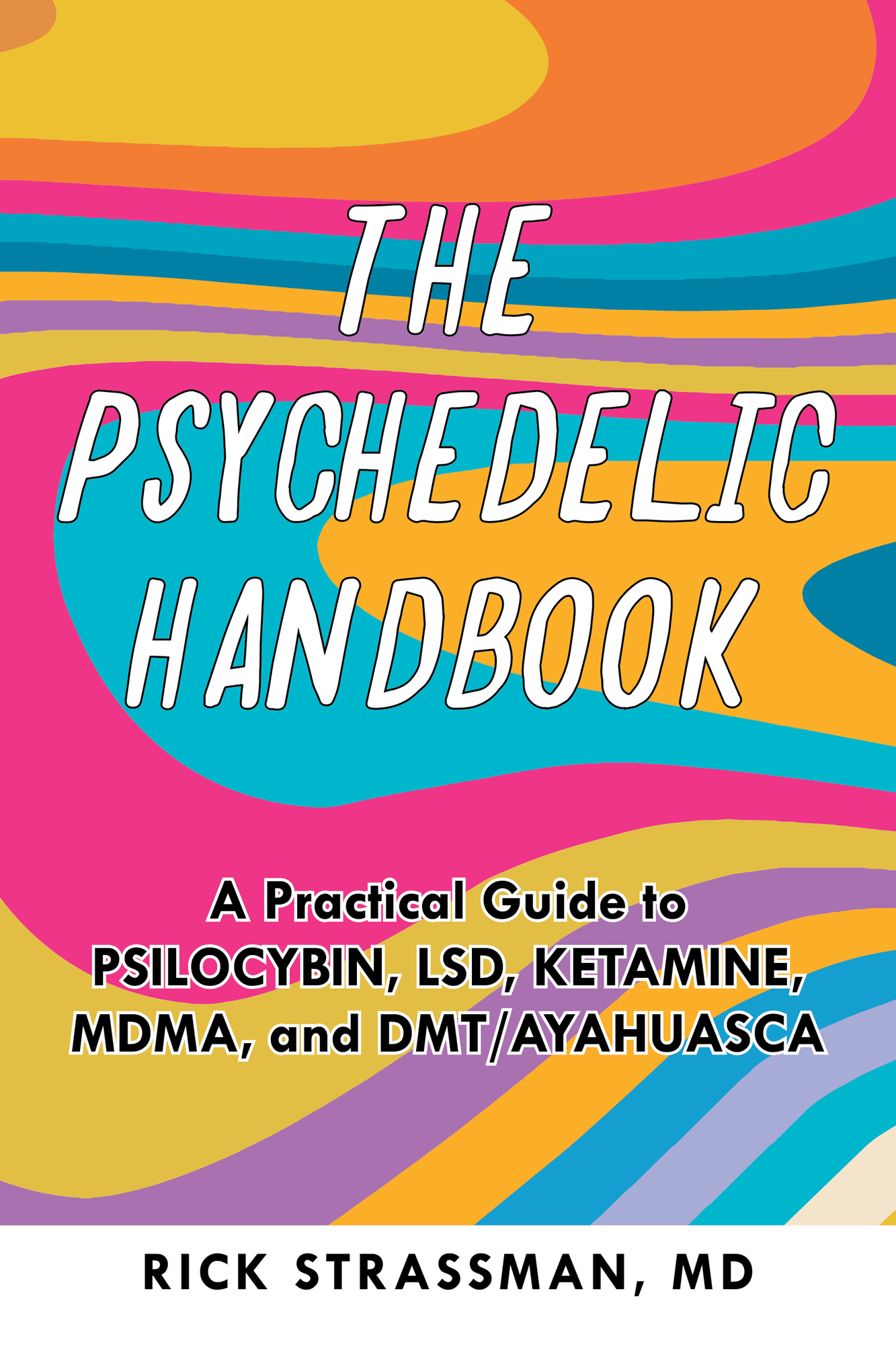Contents
Guide
The Psychedelic Handbook
A Practical Guide to Psilocybin, LSD, Ketamine, MDMA, and DMT/Ayahuasca
Rick Strassman, MD
For Emily Ellingson, MD (19782010)
AUTHORS NOTE
This book is about the history and science of psychedelic drugs, as well as their uses, potential benefits, and risks in everyday life.
I ask the reader to consider all of the following cautions before using any of the information in my book.
PSYCHEDELICS USED IN THIS BOOK. My book is limited to discussions of psilocybin; LSD; mescaline, peyote, or San Pedro; ketamine; salvinorin A or Salvia divinorum; MDMA; 5-methoxy-DMT or the venom of the Colorado River/Sonoran Desert toad; ibogaine; and DMT or ayahuasca. At no point am I referring to prescription or illicit opiates; amphetamines or methamphetamines; nitrous oxide; alcohol; sedative-hypnotics; cannabis/marijuana; bath salts; cocaine; research chemicals; volatile inhalants such as gasoline, paint thinner, or glue; or any other drug not explicitly referenced here.
POSSIBLE POSITIVE HEALTH EFFECTS. Preliminary clinical research data suggest psychedelics have a role to play in treating a variety of mental health conditions, but none are yet approved by the US Food and Drug Administration except for a proprietary brand of ketamine in those with cases of treatment-resistant depression who are currently taking an antidepressant. While people who microdose find the practice helpful, there are no scientific data supporting these claims.
POSSIBLE NEGATIVE HEALTH EFFECTS. The use of psychedelics may result in negative psychological and/or medical health effects, and so does the discontinuation of medicines that you may be taking now if you wish to stop them before taking a psychedelic. Some of the potential side effects, risks, and drug interactions are discussed in detail in Chapters 3 and 11. As noted below, you should discuss the health risks of taking a psychedelicand the best way to reduce those riskswith your healthcare provider. Not doing so can result in serious consequences, including emotional and mental problems such as anxiety, depression, suicidal thoughts, psychosis, and flashbacks.
CONSULT YOUR HEALTHCARE PROVIDER. Although I describe how psychedelics may interact with your health needs, including your medications, it is very important for you to consult your own primary care and/or psychiatric provider before using any psychedelics and before decreasing or stopping any medications that you may be using if you wish to do so before taking a psychedelic. The decision about whether to take a psychedelic is yours, but it depends on your own health issues. You should discuss the benefits and risks with a suitable healthcare provider before making a decision.
LEGAL RISKS. Possessing or consuming a psychedelic may lead to arrest and criminal prosecution. Most psychedelics are categorized under federal law as Schedule I controlled substances, the most restrictive class of drugs, and they are defined as drugs with no currently accepted medical use, a lack of accepted safety for use even under medical supervision, and a high potential for abuse. Some states and municipalities have legalized and decriminalized these substances for personal use, but federal law supersedes state and municipal law, and state law supersedes municipal law. Therefore, that doesnt mean that possession of and/or using a psychedelic are entirely without legal consequences, including arrest and conviction for a crime. Before acquiring and/or using psychedelics, you must check with your local authoritiesand consult an attorneyto determine what legal risks you are taking. The risk is even greater if you share these substances with others.
NO ENDORSEMENT. I have conducted extensive research for my book, and several of my sources are mentioned in the Acknowledgments and Recommended Reading. However, all of the opinions and advice in the book are mine alone, and no endorsement or affiliation with my sources is claimed or suggested.
GUIDING OTHERS. If you plan to use my book as a resource to help guide others, you should give all of these cautions to the people with whom you work.
PREFACE
The seeds for The Psychedelic Handbook first appeared in my childhood dreams. Dreams, much like psychedelic experiences, clarify for us feelings and thoughts that, while already existing in our minds, remain frustratingly obscure in the normal state of consciousness. Both psychedelics and dreams, therefore, are mind manifesting or mind disclosingthe traditional understanding of the word psychedelic.
My dreams were of flying and its accompanying joy. There was a freedom and exhilaration, a newfound level of self-intimacy, and a riveting visual perspective of the world around me. So, when I had my first psychedelic experience in my late teens, it felt familiar. At the same time, I had to know moreboth about the psychedelic experience personally and how psychedelics worked. From that point onwardthrough college, medical school, and psychiatric and clinical research trainingI never lost sight of these long-term goals.
Substances that produce psychedelic effects are first and foremost chemicalsspecific molecules with specific properties. Even in college, it was clear to me that chemistry was essential in understanding how psychedelics affect the mind. Chemistry always fascinated me, especially fireworks. Creating fireworks provided a satisfying intellectual challenge, the results of which were exciting displays of color, sound, and smell. There was the additional element of danger, treading on the edge of the forbidden in order to access fascinating sensations and thrilling emotions. I began college as a chemistry major, thinking I would become a fireworks magnate. Family and friends dissuaded me instead to pursue medicine. However, I never completely gave up my love of brilliant colors and edgy feelingsI simply transferred their location from the outside world to the inside of the mind. This was how I made my way into psychedelic research. It is a classic case of research is me-search.
Twenty years after my first psychedelic experience, one sunny and cold November day in Albuquerque in 1990, my dreams came true. This was when I administered the first dose of the powerful psychedelic drug DMT into the arm of a human volunteer in the General Clinical Research Center of the University of New Mexico. The US National Institutes of Health funded, and the FDA and DEA approved, this projecta series of rigorous psychopharmacology dose-response studies. We wished to determine what DMT and psilocybin did in a group of healthy human volunteers.
I had previously discovered the first known function of melatonin in humans in my search for a spirit molecule. Now, with a pediatric neuroendocrinology professor helping guide this studys development, I applied the same psychopharmacological principles to examining psychedelic drug effects.
These studies began the renaissance in clinical research with psychedelics in the United States. Before I finished the project five years later, I had administered four hundred doses of DMT at various strengths to over fifty subjects. We also began administering psilocybinthe primary ingredient in magic mushroomsto human volunteers. This was the first new American study with this compound as well. We gave psilocybin only twenty times, but in so doing generated preliminary data regarding effects of various doses and provided guidance for subsequent American studies with it. These protocols established the regulatory and scientific platforms that all subsequent American studies have used. In addition, the psychedelic drug effect rating scale we developed at UNM in the early 1990s continues in widespread use within the research world. Now, we see a veritable explosion of interest in psychedelic drugs: academic, scientific, media, religious, therapeutic, and commercial. An accessible, thorough, neutral, expert introduction to these compounds is thus timely.


